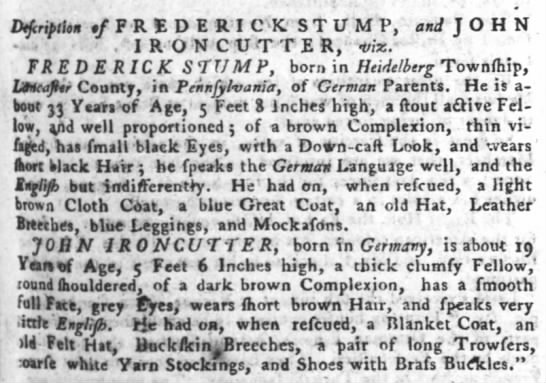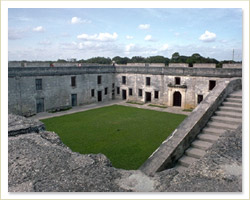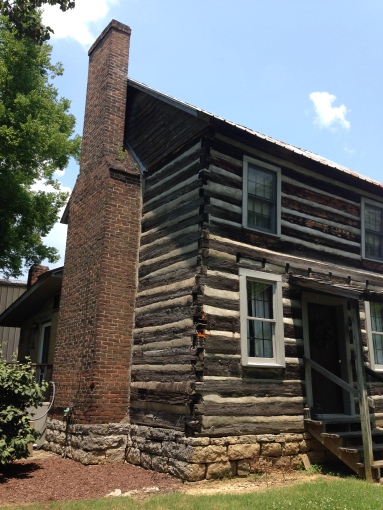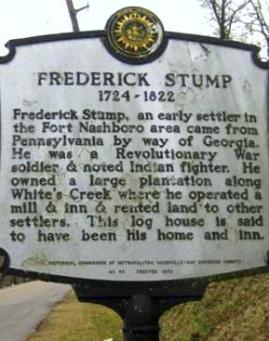
Frederick Stump was on the run. Tagged as an “Indian killer” and a fugitive in Pennsylvania, he eventually made his way down through the colonies to Georgia. There he settled with his family in the back-country on the Savannah River north of Augusta, once again building a home, a grist and saw mill and establishing a prosperous farm.
Not long after moving to the area, talk of revolution was in the air. But Stump wanted no part of it. He signed his name to a document that declared he and other colonists were not in alliance with the disgruntled citizens who met in Savannah in August of 1774. Stump and other colonists felt the meeting was dishonoring to the British King, Lords and Commons and they wanted to make sure the British knew they had no part in it. Stump didn’t want to jeopardize the protection the British provided him against the Creek and Cherokee tribes in the region.
But as the years of revolution wore on, Frederick Stump eventually found himself against the King and on the side of the patriots. In the South Carolina and Georgia areas, the British began enlisting the support of Creek and Cherokee tribes against the colonists. Therefore Stump took up arms against the British and likely fought in the Battle of Kettle Creek in February of 1779 in which the Americans were victorious, and in the Battle of Brier Creek in March of 1779 in which the British routed the patriots and took many of them captive. Legend says that as the Americans were retreating from one of the battles Frederick Stump came upon a group of British officers playing cards. In his audacious manner he killed five of the officers. Stump was captured. He was then sent to the British fortress prison in St. Augustine, Florida where his life was taking yet another turn — again, not in a positive direction.
 Stump spent four months in the Castillo de San Marcos, the Spanish-built coquina-stone fortress. The British had gained control of it from the Spanish in 1763 and were using it as a prison for revolutionary fighters. Legend says that the reason Stump only spent four months in the impenetrable prison was that he bribed the jailer with ten guineas — gold British coins equivalent to about $2000 today.
Stump spent four months in the Castillo de San Marcos, the Spanish-built coquina-stone fortress. The British had gained control of it from the Spanish in 1763 and were using it as a prison for revolutionary fighters. Legend says that the reason Stump only spent four months in the impenetrable prison was that he bribed the jailer with ten guineas — gold British coins equivalent to about $2000 today.
After his escape, he made his way through hostile back-country to his home in Georgia. Upon his arrival he found that the British had burned his grist and saw mills and had confiscated his property with his 20 slaves. In addition to this horror, the British had a bounty on his head, dead or alive. Once again, his life in shambles, Frederick Stump, 55, set out with his family for a better life…somewhere.
Heading north toward the Appalachians he joined with one of several groups heading to the frontier of Kentucky and middle Tennessee (then part of western North Carolina). He came alongside Amos Eaton’s group who followed a week behind the famed founders of Nashville, James Robertson and John Donelson. These teams led settlers from the Watauga settlement in North Carolina to the French Lick area of middle Tennessee — Robertson over land and Donelson by way of a water route.
In November of 1779, the Robertson party consisting of men, boys and animals left the Watauga settlement and headed west. The Donelson Party would follow later by boat with the women, children, and other men. The Robertson Party reached French Lick on Christmas Day 1779. The Eaton party along with several other groups from the south and east arrived around January 1, 1780. They all made their way to French Lick during one of the coldest winters on record. It was so cold that they were able to cross the Cumberland River easily from bank to bank due to it being completely frozen.
Frederick Stump, Amos Eaton and the others in his party built a “station” or fort for protection. They would settle on the northeast side of the river and Robertson’s party settled where Nashville, TN now stands on the west side of the Cumberland. The Donelson party had much trouble on their journey. They would eventually make it to French Lick by February of 1780.

After surviving the terrible winter and trying to build homes while under attack by native American tribes, that spring in May, the settlers officially founded Fort Nashborough and its government by signing of the Cumberland Compact. Frederick Stump was one of 100 signers of the document.

He would rebuild his life once more and become financially successful one more time through farming, running a inn and tavern in his large log home, and by distilling and selling whiskey. In fact he was the first to begin distilling whiskey in the region. In October of 1792, his distillery was burned by one of the area tribes, but by 1795 he was producing up to 600 gallons of whiskey a year.
His wife Ann who faithfully followed him through all of his ups and downs was herself an astute business woman. I am sure that he gained much more in his life due to her strength and wisdom.
There are many more tales to tell of Frederick Stump — most I am sure are based in fact, but they have taken on a legendary feel. One story tells of his close call with a tomahawk; another of his son being killed by native Americans. It was also said that even though he would offer his tavern for use by local Christian congregations on Sundays and some week days, only to the Moravians did he serve free dinners.
 He knew Andrew Jackson, but thought Jackson was an upstart. Still Stump served under his command as a captain in the Tennessee Volunteer Riflemen and Cavalry in the war of 1812 — when Stump was 90 years old.
He knew Andrew Jackson, but thought Jackson was an upstart. Still Stump served under his command as a captain in the Tennessee Volunteer Riflemen and Cavalry in the war of 1812 — when Stump was 90 years old.
One of the best stories of all is that at age 93, after his wife of many years had passed on, he married again…to Catherine Gingery — the 25 year-old bar maid who worked in his tavern.
Frederick Stump died at age 99 after living a full and adventurous life. The log home that he built on White’s Creek north of Nashville still stands. Over 230 years-old it is a monument to his determination, bold and incorrigible nature, and enterprising spirit.
Frederick Stump and Ann Snavely Stump are my fifth great-grandparents.
Frederick Stump was my 4th greatgrandfather. He never let life get him down, nor destroy his faith that things would get better.
Nice to meet you, Cousin Betty!
As far as I know we aren’t related, however I have been reading a lot of history and am very interested in the history of the Stump family. I live on property that Fredrick Stump Jr. owned near Bowling Green KY. I have the property over looking the Barren River where Fredrick Jr. was killed by the Harps, it’s known as Stump Bluff. Being a history buff. I have been into historical re-enacting forever it seems like. More than 30 years ago I formed a black powder club, naming the group Stump Bluff Militia. Don’t let the name “Militia” scare you we only shoot flint lock muzzleloading rifles.
Since I’m in to reenacting and now I retired I started making reproduction copper ware from the time period, named Stump Bluff Trading Post. As you can see your ancestors still have an influence in the modern age of tech knowledge.
I’m so thrilled to hear this! Thank you for letting me know how you are carrying on the Stump name and especially for keeping history alive.
I have never investigated the wareabouts of the exact location of the land where Frederick Jr was killed. I used to live in Bowling Green long before I knew any of my family’s history from there. I make it back there occasionally and I would love to meet you sometime and see your place. I will email you for more information about the property. Thank you so much for sharing!
Frederick Stump was my fifth great grandfather through Anne Stump who married Jonathan Guice. There are many Guice descendants here in MS. Terry Blackmon. Terry.Blackmon@ymail.com. P/S–Jacob Guice is buried in our family’s cemetery in McNair, MS.
Terry,
Frederick Stump was my GGGGG Grandfather, also. I think I met you at one of the Guice family reunions in the 1980’s. Leslie Guice was my Grandmother.
Hi Terry,
Nice to meet another cousin! I was fortunate enough to be able to visit the family cemetery in McNair. In fact my post on this site called “The Grave of the ‘General'” is about my visit and about Jacob Guice’s gravemarker.
My mother, father and my family went to the Guice Reunion near McNair back in 2008. My mother “won” the Guice box for the next year, but she died in early 2010. They haven’t had another reunion since…at least not one of which I’m aware. So I still have the box. If you hear of them having another reunion, please let me know!
Well, hello Cousin. Seems the same blood courses through our veins.
Hello: Lovely site, just one correction. Frederick Stump was my 5th great grandfather, through his daughter Barbara Stump who married Phenias Cox. Frederick had two structures in Davidson County, Tennessee. His log cabin home was on the east side of White’s Creek and the Inn/Tavern was on the west side. Both were standing in 1993, when I visited and I have photos of both if you are interested. Thanks for posting. Sincerely, your cousin, Allice Burns Reynolds
Thank you for your comment. I will look for the other structure you mentioned the next time I go through Nashville. I had never heard of a second structure, and the historic information I have seen only mentioned his tavern/inn on Whites Creek, so I assumed it was also his home.
Hello! I teach history in Pennsylvania, and I have a student group researching Stump’s story from this end of the tale (we’re at Susquehanna University, about one mile from the killings on Middle Creek). Could you tell me how you know that the Frederick Stump in PA is the same Frederick Stump who settled in TN? Any documents that show this trail? Thanks!
The information from books and historic markers are the first links I can share off the top of my head. I am on vacation at present so I am not near my sources, but the book that I remember that tells several stories about him in the Nashville area and connecting him back to Pennsylvania is “Seedtime on the Cumberland.” When I get back I will send you whatever else I have.
“Seedtime” and “Flowering on the Cumberland” are both written by Harriet Simpson Arnow. I believe both books mention him. There is also an historic market in front of his tavern on Buena Vista Road north of Nashville that states his trail from Pennsylvania to Georgia to Fort Nashborough.
I would love to see your students’ project when they are done. Frederick Stump is quite an interesting character!
My mother was a Guice, and Frederic Stumpf was my fifth great grandfather. A transplanted Mississippian (or perhaps a returning Tennessean), I have lived in Nashville since starting college here in 1966 and have a family tree compiled by my grandfather, Charles Edwin Guice, that shows “Jonathan Guice of Mississippi married Anna Stumpf of Tennessee” as the initial entry at the base of the tree. I understand that Jonathan Guice had lived in Nashville before relocating to Mississippi and probably knew Anna Stumpf, Frederick’s 14th child, from his time in Nashville. My grandfather, born in Port Gibson, Mississippi, was a Presbyterian minister, perhaps trying to atone by proxy for the misdeeds of his ancestor.
There is quite a bit of information about Frederick Stumpf in the Nashville Public Library including confirmation of his days in Pennsylvania, his capture and escape during the Revolutionary War and his signing the Cumberland Compact (the early governing document for Nashborough). I have read that he amassed a banking and real estate fortune and then lost it during the depression around 1812, only to rebuild it later. Sadly, I am not aware that any of it has passed to this generation to make our lives easier. I understand that he is buried in the Old Nashville City Cemetery although I have not tried to confirm that fact.
The two structures he built are still standing. The one pictured above is occupied and was purportedly used as a tavern and home. The other is on the nearby Baltz farm, standing near the home where the Baltz family now lives. They have maintained it and use it as an adjunct to their home with its fireplace being part of a cozy living area. Both structures are two story log structures in the style built by Pennsylvania Dutch. I have been in both and feel fortunate to have walked in the footsteps where our forebears lived, but wonder how 14 children were raised in those tight quarters.
I had the pleasure of spending a day several years ago with a man (now deceased) who lived in the Whites Creek area and knew quite a bit about the Stumpf family. He showed me where one of the Stumpf descendants had lived, but she is no longer living. I have not located any other Stumpf descendants in Nashville, but with 14 Frederick Stumpf children, it is inconceivable that that I am the only one in the area.
I would be pleased to learn from other cousins what you know about our Stumpf and Guice families.
Thank you so much for sharing! I have researched Frederick Stumpf in the Nashville library when I used to live in Bowling Green, KY. I also recently visited and went into the Stump home on the Baltz farm. I’m so thankful that they have kept it up so well. I did not know that Frederick Stumpf had 14 children! I am descended through Jonathan and Anne. I would love to see the family tree you have. I will contact you privately to see if we can visit when I go through Nashville.Nice to meet you cousin!
For some reason I am not able to see your email. Can you please contact me today via my email (Ladyguice@bellsouth.net)? I will be passing through Nashville on Sunday morning (June 19).
Frederick Stump is a great grandfather of mine. My Grandmother was a Stump from Michigan. I just happened on the account of the indian’s being killed by him from some of my father’s paperwork I have been going through. I did not know there was so much information regarding his life. I am related through John Stump, then Daniel Webster stump, and then my grandmother louella stump.
I recently discovered that I am a descendant of Frederick Stump, James Thompson, Robert Thompson, and Jacob Castleman, all signers of the Cumberland Compact. General James Robertson, the “Father of Tennessee” was the brother to my direct ancestor, Rhoda Patience Robertson. They were all pioneers that either crossed the mountains or rode the flotilla to the Salt Lick. My grandmother’s great-great-grandmother was Rhoda Thompson. She was born there near Nashville on the frontier in 1795 and married the Reverend Francis Stead Perry, moved to Bigbyville, TN, where they built a Methodist Church and raised a large family, but suffered greatly in the Civil War, losing my great-great grandfather, James Thompson Perry, in his fight for the confederacy. I’m still learning, am grateful for every bit of knowledge, and willing to share what I find.
By the way…Where’s part 1?…
What an interesting set of ancestors, Cousin!
Part 1 is called Savagery on the Susquehanna. If you click on the search box on the blog page and search Frederick Stump it should bring up Part 1, Part 1a and Part 2. Thanks for letting me know about your family!
My ggg-grandfather was Dr. Wiley Turner Perry, the son of Rev. Perry and Rhod a Thompson, but I always thought Rev. Perry was Presbyterian. Dr. Wiley Turner Perry, was an asst surgeon with the 3rd Tenn Infantry and died shortly after war.
This is all so very interesting. I am kin to Frederick Stump via his daughter Anna’s marriage to Jonathan Guice. My father was able to visit the home many years ago. It is wonderful to hear the stories of our ancestors. I am always eager to learn more about them.
Then we must be fairly close cousins! I descend from Anna and Jonathan Guice’s son Jacob.
I currently live in the old Stump tavern on Buena Vista Pike. I would love to gather as many details and possibly pictures as I can about the tavern so I can bring it back to it’s original glory. There has been a lot of updates and remodels done to the tavern over the years.
I know that at some point the tavern originally sat closer to Buena Vista Pike but was moved back at least 100′ but I’m unsure of when that was done.
I also know that at some point there use to be an opening (dog-trot) in between the two parlors but not sure when it was changed.
That’s fantastic! I have passed by it many times and wondered who lived there and was wishing someone would restore it. Yes, I knew it had a dog trot originally. How long have you lived there?
The new marker was put in front of the tavern last week by the Historical Commission
Is there a way to see a photo of it? Is the wording still the same?
Unfortunately I don’t think I can post pics in the reply box on this site but if you would like to email me then I can send them to you, kurtmactomais@gmail.com
I am doing some research about the history of White’s Creek Tennessee and would welcome the opportunity to ask an ancestor of Col. Stump a couple of questions regarding his history in relation to the city. Would you consider entertaining some questions in that regard? In particular, I am wanting to know if he built a station of fort, and also if there is any information about any camp meetings in this area from 1778-1805? I am a history buff, and any help is greatly appreciated! Glenda Clark
Certainly, I can. To my knowledge he did not build a fort or station, only his tavern on the west side of White’s Creek and his house on the east side. They are a couple of hundred yards from each other.
By camp meetings, you mean religious gatherings? If so, I am not aware of any. I will contact you by email in case you have further questions.
Frederick Stumpf is my fifth great grandfather. My mother is June Guice, a descendant of Frederick Stumpf’s daughter, Ann, and Jonathan Guice. I live in Nashville and have had the opportunity to tour both the tavern and the house, both of which are still in use. It was fun to walk in the same spaces where our ancestors lived over 200 years ago, look at the same walls, floors and fireplaces, and imagine what their lives were like. Amazing to know these structures survive from the 1790s and are still in use. It pleases me to know this website is here to connect and educate us.
Hi all
I am a descendant of Frederick Stump and have visited the tavern several times as well as the original cabin. I along with cousins Alice Reynolds worked with the Tennessee HIstorical Commision and rewrote and updated the new marker that was recently install. Looking forward to meeting Kurt in Sep and seeing tavern once again. Love that place. I have researched Frederick and the tavern extensively and would love to talk to you too Glenda Clark – Randy Pace – grandypace@aol.com
Hello, my grandmother was from Nashville, TN, and her name was Anne Myrtle Stump Shaffer. She told me the wild stories of her great-grandfather, Frederick Stump, when I was a child. At age 9 in the 1970s, we went to TN to visit Frederick Stump’s former home, pictured above in your story. I guess this means we are likely cousins.
She left TN in 1918 to pursue her college education at the University of Chicago, where she met her husband to be, Joseph Shaffer. I have very old newspaper articles in my family tree folder of all of the Frederick Stump history.
Yes, we are cousins! Thank you for the information about your grandmother. I would love to see the old newspaper articles some day.